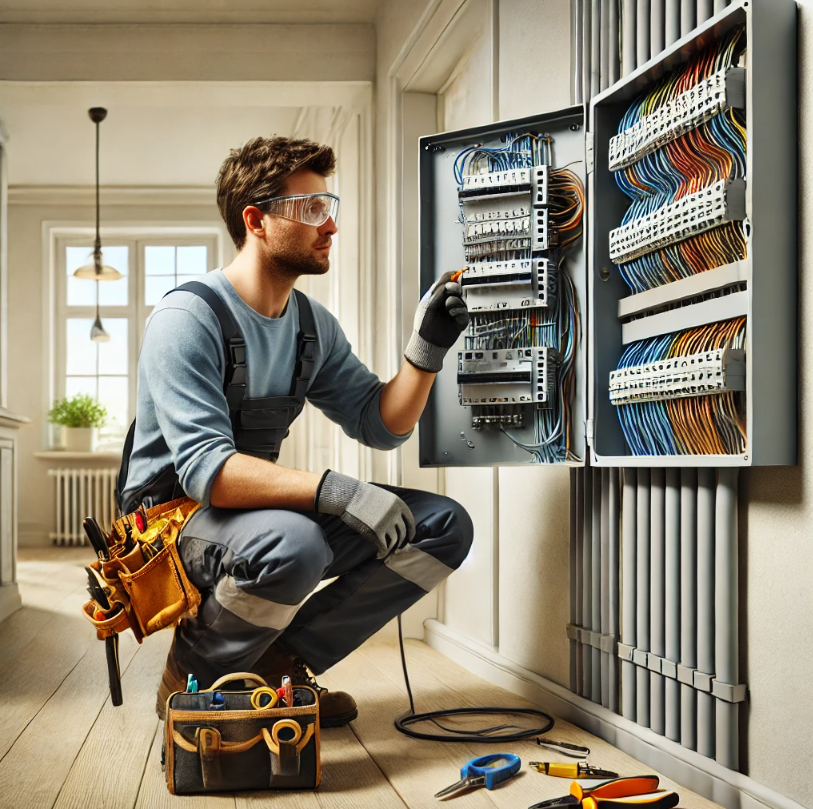
Important summary of UK regulation for electrical installations in houses
Here's a concise summary of UK regulations for electrical work in residential properties and what you need to do if you want to DIY.
ELECTRICAL
12/19/20242 min read



Key Electrical Regulations in the UK
Governing Standards:
Electrical installations must comply with BS 7671: Requirements for Electrical Installations (IET Wiring Regulations).
Part P of Building Regulations:
Applies to dwellings, including houses, flats, and gardens.
Requires that electrical work be safe and comply with Building Regulations.
Notifiable Work (must be reported to local building control or performed by a registered professional):
Installation of new circuits.
Work in bathrooms, kitchens, or outdoor areas.
Consumer unit (fuse box) changes.
Non-Notifiable Work (can be done by a competent DIYer):
Replacing sockets, switches, and light fittings.
Minor repairs or maintenance.
Qualified Persons:
Electrical work should be carried out by:
A competent person registered with a Part P self-certification scheme (e.g., NICEIC, NAPIT).
Or inspected by building control if not performed by a registered electrician.
Certificates:
Electrical Installation Certificate (EIC): Issued for new installations or significant changes.
Minor Electrical Installation Works Certificate: For small jobs.
Electrical Installation Condition Report (EICR): Regular inspection to ensure safety.
Bathroom and Kitchen Work:
Special rules apply due to proximity to water.
Zone classifications (e.g., Zone 0, Zone 1) determine what kind of fixtures are permissible.
Consumer Units:
New installations must use metal-clad consumer units for fire safety.
RCD Protection:
Required for circuits in all new installations to prevent electrical shock.
Portable Appliance Testing (PAT):
Not legally required for homeowners but recommended for rented properties.
Renting and Landlord Requirements:
Electrical Safety Standards in the Private Rented Sector (2020):
Mandatory EICR every 5 years.
Immediate remediation of hazards.
Penalties:
Non-compliance can lead to fines or enforcement action by building control.

if you are doing DIY electrical work in the UK and the work is notifiable under Part P of the Building Regulations, you will need to pay for building control to inspect and certify the work. Here's how it works:
When Building Control Inspection is Needed
Notifiable Work:
Installing new circuits.
Rewiring or significant alterations.
Electrical work in high-risk areas (e.g., bathrooms, kitchens, or outdoor installations).
Replacing the consumer unit (fuse box).
Process:
You must notify your local building control office before starting the work.
Building control will:
Inspect the work during and/or after completion.
Test the installation for safety and compliance with BS 7671.
Costs:
Fees vary depending on the local council and the scope of the work.
Typical fees range from £200 to £400 for inspection and certification.
Certificates:
If the work passes inspection, you will receive a Building Regulations Completion Certificate and potentially an Electrical Installation Certificate (EIC).

Alternative: Using a Registered Electrician
To avoid building control fees and streamline the process:
Hire an electrician registered with a Part P Competent Person Scheme (e.g., NICEIC, NAPIT).
Registered electricians can self-certify their work and provide you with the required certificates directly.Alternative: Using a Registered Electrician
To avoid building control fees and streamline the process:
Hire an electrician registered with a Part P Competent Person Scheme (e.g., NICEIC, NAPIT).
Registered electricians can self-certify their work and provide you with the required certificates directly.

